The only trouble with these far off places is that I keep meeting new fishing nuts with great stories of must see places and must catch fishes and that list never seems to get any shorter – let me explain why.
It is a matter of public record that I stood down from Parliament in April 2010 to ‘spend more time with my fish’. The first 15 months or so were taken up with a rather wonderful fishing sabbatical in Australia where I caught all manner of incredible species.
I fell in love with the sheer power of the yellow tailed kingfish, with the explosive take, or ‘boof’, of a barramundi as it engulfs a lure and with the awesome leaps of a marlin or sailfish out wide in a cobalt blue ocean. But the more you catch the more you learn and the more the addiction grows. For example, three years ago I had never heard of a rooster fish and now I’m making plans to catch one for my 60th birthday!
Anyway I’m getting ahead of myself. The Aussies kept telling me about the sheer brutality of the giant trevally or GT and my fly fishing friends were equally enthusiastic about the fighting qualities of the bonefish, a species I had long hankered after. Upon returning to the UK these were added to the bucket list and thanks to some late cancellations and some very good fortune I found myself invited to assemble a party at short notice for a saltwater fly-fishing expedition to the Seychelles where bonefish were said to be abundant and the GTs were simply huge. The UK end of the trip was organised with impressive efficiency by the excellent Aardvark Mcleod who booked us on flights to Alphonse Island via Dubai and the Seychelles capital of Victoria.
Alphonse Island
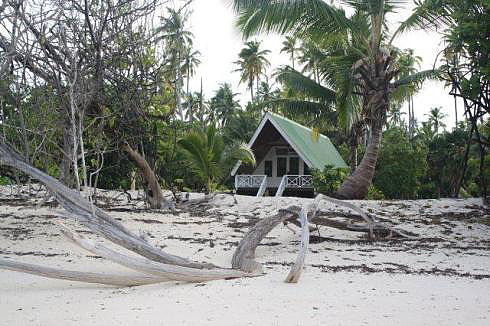 Now Alphonse, and the adjacent St François Lagoon, has a reputation as one of the finest bonefishing destinations in the world and is part of the Amirantes group of islands in the Indian Ocean. In addition to the abundant bonefish (ranging in size from 3 – 9lb) there are three species of trigger fish, five species of trevally and a plethora of other flats and offshore species. Perhaps the most challenging fish to catch is the fabled milkfish; a turbo charged algae eater growing to 40lb. The guides on Alphonse Island have pioneered techniques which have allowed these vegetarian and notoriously difficult fish to be caught. However, I decided that my somewhat agricultural fly casting technique was wasted on the milkfish and decided to concentrate on learning how to catch those wonderful bones and seeing if a fly rod really was up to the job of subduing an angry GT.
Now Alphonse, and the adjacent St François Lagoon, has a reputation as one of the finest bonefishing destinations in the world and is part of the Amirantes group of islands in the Indian Ocean. In addition to the abundant bonefish (ranging in size from 3 – 9lb) there are three species of trigger fish, five species of trevally and a plethora of other flats and offshore species. Perhaps the most challenging fish to catch is the fabled milkfish; a turbo charged algae eater growing to 40lb. The guides on Alphonse Island have pioneered techniques which have allowed these vegetarian and notoriously difficult fish to be caught. However, I decided that my somewhat agricultural fly casting technique was wasted on the milkfish and decided to concentrate on learning how to catch those wonderful bones and seeing if a fly rod really was up to the job of subduing an angry GT.
The accommodation on the island was first rate with individual A-framed chalets offering a beach setting and comfortable living quarters. Transport to the restaurant, bar and fishing centre was by bicycle which only added to the charm. Each day began with an alarm call at 5.30am, an early breakfast and a rendezvous with guides at 7am.
The fishery caters for just ten anglers, two per skiff, and guests are guided by some of the most experienced saltwater guides in the world hailing from South Africa, America and the Seychelles itself. Each morning we were transferred for the short run from Alphonse to St François lagoon by a 40ft mothership to where the skiffs are anchored. The fishing was very much tide dependent so the prevailing conditions tended to dictate which species we targeted but GTs and bones were always a possibility at some point in the day. In addition the lagoon has five finger flats stretching across the central area from which it proved possible to catch beautiful spangled emperor, hard fighting bohar snapper and the apparently tricky trigger fish, one of which luckily fell to my rod on the first day.
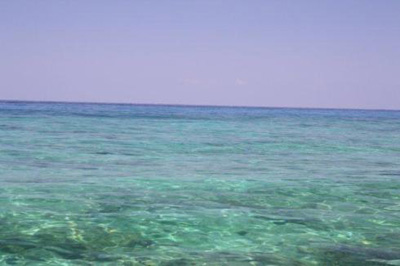 When the light was good it was possible to see all manner of fish drifting out of the reefs below the boat. On the flats the bonefish would often materialise from nowhere meaning that a quick cast in the right area would more often than not illicit some interest from these fast moving ‘silver ghosts’. I learnt to spot the difference between shadows that looked like fish and fish that looked like shadows. Perhaps even harder than spotting the bones and placing the cast in the right place was learning not to lift the rod on the take but to continue smoothly stripping to set the hook and trigger that first pulsating, reel screaming run.
When the light was good it was possible to see all manner of fish drifting out of the reefs below the boat. On the flats the bonefish would often materialise from nowhere meaning that a quick cast in the right area would more often than not illicit some interest from these fast moving ‘silver ghosts’. I learnt to spot the difference between shadows that looked like fish and fish that looked like shadows. Perhaps even harder than spotting the bones and placing the cast in the right place was learning not to lift the rod on the take but to continue smoothly stripping to set the hook and trigger that first pulsating, reel screaming run.
By the end of the week I reckon I had the bones cracked and was firmly of the opinion that fly fishing was the best and most efficient way of catching these shallow water speedsters. However, the GTs were a different proposition altogether and I was going to take some convincing that even a Hardy twelve weight was an appropriate tool for taming these beasts.
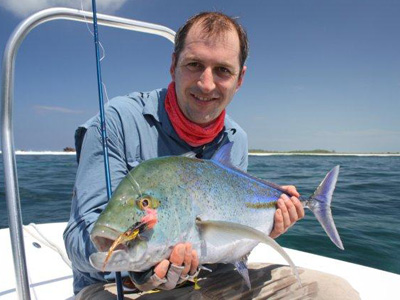 The traditional way of tempting a GT is to fish a surface popper either across a recognised ambush point where the fish might be lurking, or to cast to a cruising or feeding fish assuming one can be found. This is exciting stuff and the tactic worked well enough for some of our party but not alas for Angling Trust boss Mark Lloyd who was comprehensively smashed by the one GT that took a fancy to his popper. However, he did have the compensation of landing some cracking bluefin trevally on similar tactics.
The traditional way of tempting a GT is to fish a surface popper either across a recognised ambush point where the fish might be lurking, or to cast to a cruising or feeding fish assuming one can be found. This is exciting stuff and the tactic worked well enough for some of our party but not alas for Angling Trust boss Mark Lloyd who was comprehensively smashed by the one GT that took a fancy to his popper. However, he did have the compensation of landing some cracking bluefin trevally on similar tactics.
I was tipped off that it was possible to put an impressive mixed bag of fish together by fishing deep along the drop off outside the reef with heavily weighted flies. The purists may sneer that ‘dredging’ was not as worthy as pure sight fishing but I couldn’t give a toss, especially when every other cast saw myself or my partner for the day, Mark Eyre, hooked up on anything from a dogtooth tuna to a golden lyre tailed grouper. I was even told that the method produces a fair number of GTs and so it proved as towards the end of the day I found myself attached to a ridiculous brute of a fish that did its best to bury me in the coral reef.
Luckily my Hardy 12 weight held firm, as did my Zane Fortuna reel, long enough for head guide Devan to power the boat into deeper water where the fish could be played out away from danger. Nevertheless, it was still a back breaking ten minutes before we had ‘colour’ and the fish was beaten. At 45lb and 97cm in length this fish more than doubled my personal best GT and was a real highlight of the trip.
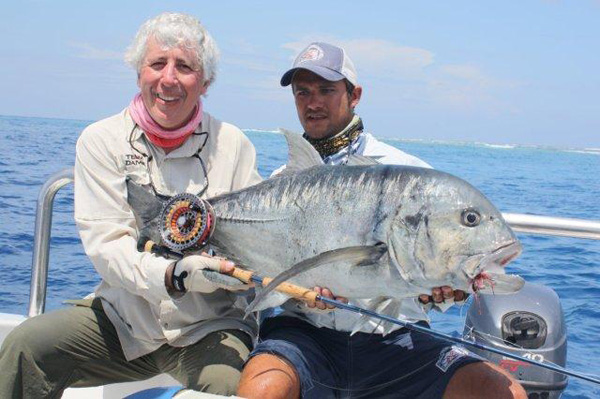
We were fishing Sunday to Friday and with both a trigger fish and GT in the bag by the end of day three I had plenty of time left to concentrate on the bones and improve my flaky fly casting. The fish didn’t exactly give themselves up but by listening carefully to the advice of the Alphonse guides even a fly fishing novice like me could rack up a respectable number of bones. I managed 12 in a morning up to 5lb but other more experienced anglers have had as many as 50 in a day which is pretty amazing sport by anyone’s standard
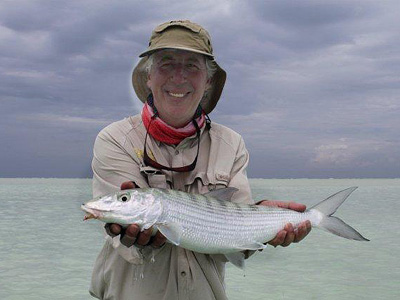 All too quickly our wonderful week came to an end and we had to say goodbye to this fantastic fishery managed exclusively and sensitively for catch and release fly fishing only. There’s much more to say about what we saw and what we learned but for now, as I contemplate how to make the most of our cold and swollen English rivers before March 14th, my mind will inevitably drift back to that bright blue sea, a screaming reel and floppy fly rod bent well beyond what its makers ever envisaged.
All too quickly our wonderful week came to an end and we had to say goodbye to this fantastic fishery managed exclusively and sensitively for catch and release fly fishing only. There’s much more to say about what we saw and what we learned but for now, as I contemplate how to make the most of our cold and swollen English rivers before March 14th, my mind will inevitably drift back to that bright blue sea, a screaming reel and floppy fly rod bent well beyond what its makers ever envisaged.
If you fancy some incredible tropical fly fishing in an island paradise check out the trips on offer from Aardvark Mcleod by clicking HERE Be warned these are not cheap places to get to but you will be in for the experience of a lifetime and I guess that what bucket lists are all about.
This feature forms part of Martin’s Fighting for Fishing blog and is reproduced on FishingMagic with his kind permission – but make sure you check out the site to keep up to date.










